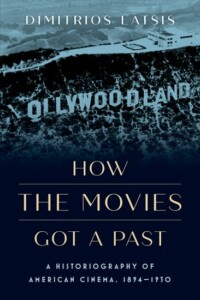
How the Movies Got a Past presents a comprehensive survey of the rise of historiographical discourse on cinema in North America as it is reflected in publications, exhibitions, lectures, and films about the cinema as a technology, form of art, and source of entertainment, from its inception up to 1930. This pioneering historiography of American movies proposes a typology of genres of historical knowledge and examines the role that its articulation played in legitimating the moving image as a form of cultural heritage and a field of study.
How did early studios seek to understand and promote their own activities as part of a brand-new form of entertainment with its own traditions, “founding fathers,” and ambitions? How did early writers modulate between retrospection and analysis, between nostalgia and ballyhoo, between journalism and research into the “relics” of the nascent film industry and what were their motivations and influence on subsequent historians? What rhetorical and material platforms were deployed to talk about and show the history of cinema and for what audiences were they meant? In teasing out answers to these and other questions, this book makes an argument for early cinema historiography as an emergent genre with its own conventions and goals instead of a “primitive” version of today’s historical writing on the movies. With a wealth of case studies, and illustrations, How the Movies Got a Past will appeal to media historians, silent movie buffs, film archivists, and students alike.
Selected reviews:
“This important book transforms our understanding of the history of early cinema by expanding on the limited range of material that past studies have drawn upon. Supported by extensive research, Latsis creates a lucid study supported by a wide range of sources, including industry self studies.” – Virginia Wright Wexman, University of Illinois Chicago
“How the Movies Got a Past fills a gap in media studies, which is the lack of any systematic account of histories of film in the first decades of cinema. Latsis presents an abundant range of source material and augments his empirical research with astute analyses in an accessible and engaging manner.” – Donald Crafton, University of Notre Dame
“Dimitrios Latsis’s groundbreaking historiography excavates a rich discourse on film history practically going back to the birth of cinema itself. It constitutes an important pre history of today’s film studies in their attempts to frame the new medium as a legitimate art, entertainment, and industry. This book should be required reading for anyone seriously interested in American film history.” – Jan Christopher Horak, UCLA School of Theatre, Film & Digital Media
“This book is a superb, deeply researched study of often dismissed early writings, from Grau to Ramsaye, bent on creating a history of cinema during its very emergence, but especially of little examined practices that likewise sought to construct a sense of cinema’s ‘usable past’-from commercial non fiction films, revivals or re-releases, and studio commemorations to public exhibitions, university curricula, and the efforts of private collectors.” – Richard Abel, University of Michigan


